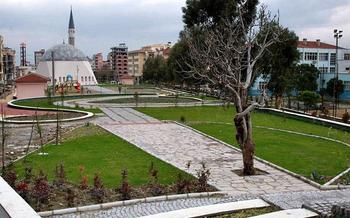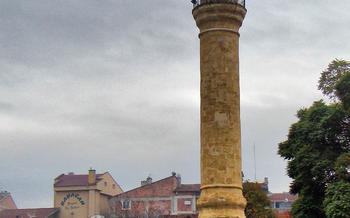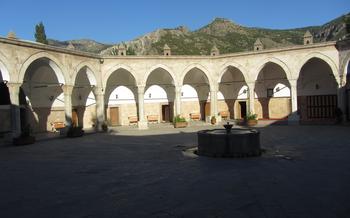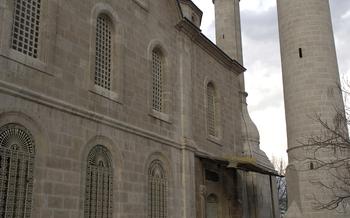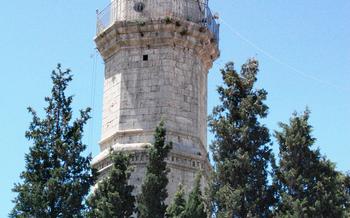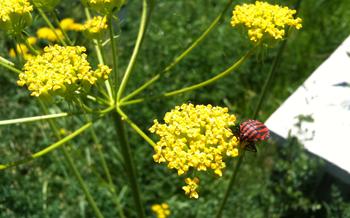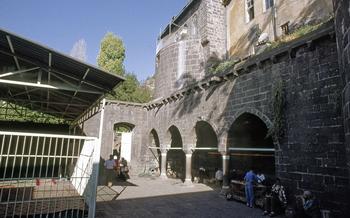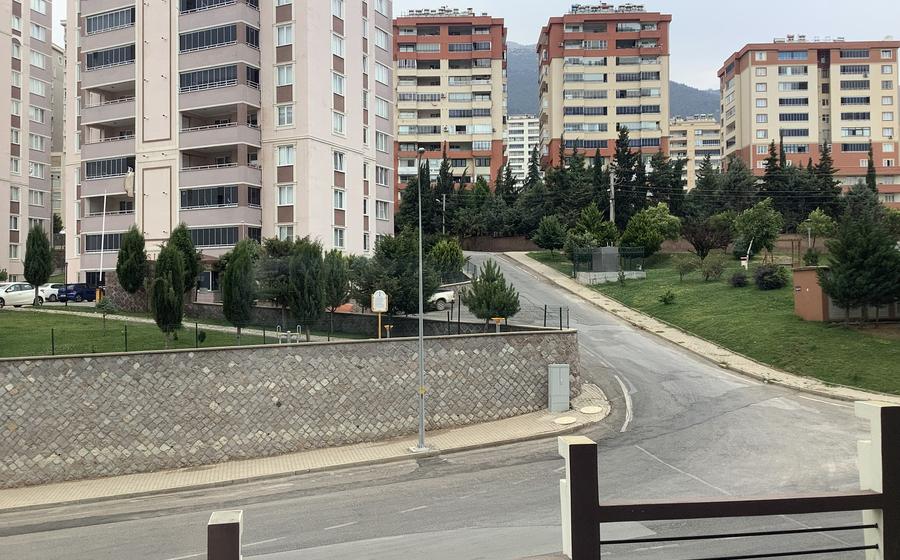
Kahramanmaras Grand Mosque and its Complex
- A Symbol of Architectural Grandeur
- Exploring the Mosque's Complex
- A Journey Through History
- A Masterpiece of Islamic Art
- The Sacred Interior
- A Place of Worship and Learning
- A Symbol of Community
- The Madrasah and Its Legacy
- The Türbe and Its Significance
- A Haven of Tranquility
- A Testimony to Craftsmanship
- A Living Heritage:
- Practical Information
- Local Recommendations
- Insider Tip:
A Symbol of Architectural Grandeur
The Kahramanmaras Grand Mosque stands as a testament to the architectural brilliance of the Seljuk and Ottoman periods. Built in the 15th century, the mosque showcases a harmonious blend of these two architectural styles. Its impressive scale and intricate details reflect the mastery and dedication of the artisans who constructed it. The use of local materials, such as sandstone and marble, adds a unique charm to the mosque's design. The interplay of arches, domes, and minarets creates a visually stunning ensemble that captivates visitors from afar. The mosque's grandeur is not only a symbol of religious devotion but also a celebration of architectural artistry.
Exploring the Mosque's Complex
Beyond the grand mosque itself, the complex encompasses a multitude of structures, each contributing to its rich history and functionality. The courtyard, the heart of the complex, provides a tranquil space for contemplation and gathering. Its meticulously landscaped gardens offer respite from the bustling city, while the soothing sound of water trickling from the fountains creates a serene ambiance.
Adjacent to the mosque is the madrasah, an Islamic school that played a pivotal role in disseminating knowledge and education. Within its walls, students from near and far gathered to study religious and secular subjects under the guidance of renowned scholars. The madrasah's legacy continues to this day, as it remains a vital center for Islamic learning and education in the region.
The türbe, or mausoleum, is another significant component of the complex. It serves as the final resting place for esteemed figures, including religious leaders, scholars, and community elders. The türbe's intricate architectural features and decorative elements pay homage to the departed and reflect the profound respect accorded to them by the community.
A Journey Through History
The Kahramanmaras Grand Mosque has stood witness to the passage of time, its history intertwined with the rich tapestry of Turkey's past. Originally constructed during the Seljuk period, the mosque has undergone several additions and renovations over the centuries, reflecting the changing architectural styles and influences of successive eras.
The mosque's foundations were laid in the 12th century, during the reign of the Seljuk Sultan Rukn al-Din Arslan Shah I. This early structure showcased the distinctive architectural style of the Seljuks, characterized by its simplicity and elegance. As the centuries passed, the mosque underwent several expansions and modifications, incorporating elements of the Ottoman architectural style.
Throughout its history, the Kahramanmaras Grand Mosque has undergone periods of restoration and preservation efforts. In the 19th century, Sultan Abdul Hamid II ordered extensive renovations to restore the mosque to its former glory. These efforts included the addition of a new minaret, the restoration of the courtyard, and the refurbishment of the interior decorations.
Today, the Kahramanmaras Grand Mosque stands as a testament to its resilience and adaptability, having weathered the storms of time and change. Its architectural elements and historical significance combine to create a unique and awe-inspiring monument that continues to captivate visitors from around the world.
A Masterpiece of Islamic Art
The Kahramanmaras Grand Mosque stands as a testament to the exquisite Islamic art and ornamentation that adorns its every corner. Intricate tilework, calligraphy, and geometric patterns dance across its walls, captivating the eyes with their vibrant colors and intricate designs. The use of vibrant blues, greens, and reds creates a sense of awe and wonder, while the intricate calligraphy invokes verses from the Quran, adding a layer of spirituality to the mosque's interior. The fusion of artistic influences from Seljuk, Ottoman, and even Byzantine cultures is evident in the mosque's design, showcasing the rich cultural heritage of the region. Each tile, each stroke of calligraphy, and each geometric pattern weaves together a tapestry of Islamic art that is both visually stunning and deeply meaningful.
The Sacred Interior
The prayer hall of the Kahramanmaras Grand Mosque is a breathtaking sanctuary that exudes an aura of spirituality and tranquility. The grand dome, adorned with intricate patterns and calligraphy, soars above, creating a sense of awe and wonder. The elaborate mihrab, the niche indicating the direction of Mecca, is a masterpiece of Islamic art, featuring intricate tilework and carvings. The minbar, the elevated platform from which the imam delivers sermons, is another exquisite feature, showcasing fine craftsmanship and attention to detail. The overall atmosphere within the prayer hall is one of serenity and devotion, inviting visitors to immerse themselves in spiritual contemplation and connection with the divine.
A Place of Worship and Learning
The Kahramanmaras Grand Mosque stands not only as a testament to architectural brilliance but also as a center of religious devotion and learning. Daily prayers, congregational gatherings, and special religious events transform the mosque into a vibrant hub of spiritual activity. The faithful gather within its sacred walls, seeking solace, guidance, and connection with the divine.
The mosque's role as a place of worship is deeply ingrained in the fabric of the local community. Muslims from all walks of life come together to perform their daily prayers, united in their faith and devotion. The mosque also hosts special religious events throughout the year, such as the celebration of Ramadan and the Hajj pilgrimage. These events draw large crowds of worshippers, creating a sense of unity and camaraderie among the faithful.
Beyond its function as a place of worship, the Kahramanmaras Grand Mosque also serves as a center for religious education. The mosque's madrasah, or Islamic school, has a long and distinguished history of providing religious and secular education to students from the local community. Notable scholars and students have emerged from this institution, contributing to the dissemination of Islamic knowledge and scholarship.
The integration of religious and educational functions within the mosque complex reflects the holistic approach to education in Islamic tradition. Students at the madrasah not only acquire knowledge of the Quran and Islamic law but also receive instruction in subjects such as mathematics, astronomy, and medicine. This well-rounded education prepares students to become not only pious Muslims but also valuable members of society.
A Symbol of Community
Beyond its religious significance, the Kahramanmaras Grand Mosque serves as a vital gathering place for the local community. It hosts a variety of social, cultural, and educational events throughout the year, fostering a sense of unity and inclusivity. The mosque's courtyard and surrounding areas become vibrant venues for festivals, exhibitions, and traditional performances, showcasing the rich cultural heritage of the region. The mosque's role extends beyond religious practices, embracing the community's social and cultural needs, strengthening bonds among its members, and promoting a collective sense of belonging. It stands as a symbol of community spirit, where people from all walks of life come together to celebrate, learn, and connect.
The Madrasah and Its Legacy
Within the complex of the Kahramanmaras Grand Mosque, a madrasah, or Islamic school, stands as a testament to the mosque's role as a center of learning and scholarship. Established during the Seljuk period, the madrasah has a rich history of providing both religious and secular education to students from the local community and beyond.
Throughout the centuries, the madrasah has produced notable scholars and students who have made significant contributions to Islamic scholarship and education. These scholars have played a vital role in preserving and transmitting Islamic knowledge and traditions, shaping the intellectual and cultural landscape of the region.
The madrasah's curriculum encompassed a wide range of subjects, including Islamic theology, law, philosophy, and the natural sciences. Students also received instruction in Arabic language and literature, mathematics, astronomy, and history. The madrasah's emphasis on both religious and secular education reflected the holistic approach to learning that was characteristic of Islamic education during this period.
Today, the madrasah continues to operate as an educational institution, offering classes in Islamic studies and Arabic language. It remains a vital part of the mosque complex, serving as a reminder of the mosque's historical role as a center of learning and scholarship.
The Türbe and Its Significance
Within the tranquil confines of the Kahramanmaras Grand Mosque complex lies the türbe, a sacred mausoleum that holds a profound historical and spiritual significance. This serene structure serves as the final resting place for several notable figures who played a pivotal role in the mosque's history and the surrounding community. The türbe's architectural features and decorative elements exude an air of reverence and respect, reflecting the deep admiration and gratitude held for the individuals interred within its walls.
The türbe's construction showcases exquisite craftsmanship and attention to detail, blending seamlessly with the overall architectural style of the mosque complex. Its intricate carvings, tilework, and calligraphy create a visually captivating ensemble that evokes a sense of awe and tranquility. The türbe's interior is adorned with verses from the Quran and other religious texts, adding to its sacred ambiance.
Visitors to the türbe are filled with a sense of reverence as they pay their respects to the individuals laid to rest within. The türbe serves as a poignant reminder of the mosque's rich history and the enduring legacy of those who contributed to its spiritual and cultural significance. It is a place where visitors can reflect on the lives of these notable figures and draw inspiration from their contributions to the community.
The Kahramanmaras Grand Mosque's türbe stands as a testament to the profound respect and admiration held for those who have dedicated their lives to serving the mosque and its community. It is a place of remembrance, reflection, and spiritual connection that invites visitors to contemplate the enduring impact of faith and devotion.
A Haven of Tranquility
The Kahramanmaras Grand Mosque complex exudes an atmosphere of peace and serenity that invites visitors to seek respite and spiritual reflection. As you step inside the courtyard, the beautifully landscaped gardens with their colorful flowers and lush greenery create a calming ambiance. The sound of water flowing from the fountains adds to the tranquility, creating a soothing symphony that helps visitors shed their worries and find inner peace. This serene environment provides the perfect setting for contemplation and spiritual connection, allowing visitors to immerse themselves in the mosque's sacred atmosphere and connect with their inner selves.
A Testimony to Craftsmanship
The Kahramanmaras Grand Mosque stands as a testament to the exquisite craftsmanship and artistry that went into its construction. Every corner of the mosque showcases intricate carvings, tilework, and calligraphy, reflecting the skill and dedication of the artisans who built it. The intricate patterns and motifs, combined with the vibrant colors, create a visually stunning masterpiece that captivates the eyes. The mosque's architectural elements, such as the domes, minarets, and arches, are adorned with intricate carvings that display the mastery of the craftsmen. The mosque's interior is equally impressive, with its elaborate mihrab, minbar, and other religious features showcasing the finest examples of Islamic art. The fusion of traditional techniques and innovative designs makes the Kahramanmaras Grand Mosque a true testament to the artistry and craftsmanship of its creators.
A Living Heritage:
The Kahramanmaras Grand Mosque stands as a living testament to Turkey's rich cultural heritage. It continues to play a vital role in the spiritual, educational, and social fabric of the local community. Daily prayers, congregational gatherings, and special religious events fill the mosque with life and devotion. The mosque complex also hosts social, cultural, and educational events, fostering community bonds and strengthening social ties.
Efforts to preserve and restore the mosque's historical and architectural integrity are ongoing, ensuring that future generations can appreciate its grandeur and significance. The mosque serves as a reminder of Turkey's rich history, architectural prowess, and the enduring legacy of Islamic art and architecture. Visiting the Kahramanmaras Grand Mosque is not just a journey through history but also an immersion into the living heritage of Turkey, where the past and present intertwine to create a vibrant tapestry of faith, culture, and community.
Practical Information
Before embarking on your visit, it's important to be aware of some practical information to ensure a smooth and enjoyable experience:
-
Opening Hours: The Kahramanmaras Grand Mosque is generally open to visitors from sunrise to sunset. However, it's recommended to check for any specific closures or changes in operating hours during special events or holidays.
-
Admission Fees: Entry to the mosque is free of charge. Nevertheless, donations are welcome and greatly appreciated as they contribute to the mosque's upkeep and preservation efforts.
-
Dress Code: As a mark of respect, visitors are kindly requested to dress modestly and appropriately when visiting the mosque. This includes covering shoulders and knees for both men and women.
-
Accessibility: The mosque is wheelchair accessible, with ramps and elevators provided for the convenience of visitors with disabilities.
-
Guided Tours: Guided tours are available for a more in-depth understanding of the mosque's history, architecture, and significance. These tours can be arranged through the mosque's administration or local tour operators.
-
Visitor Services: The mosque offers a range of visitor services, including brochures, booklets, and guided tours. Additionally, there are restrooms and ablution facilities available for the convenience of visitors.
Local Recommendations
Your journey to Kahramanmaras is not complete without delving into the city's culinary delights and exploring its rich cultural tapestry. Just a short walk from the Grand Mosque, you'll find yourself at the heart of the bustling bazaar, where you can savor the aromas of traditional Turkish cuisine. Indulge in the irresistible flavors of freshly baked pide, a boat-shaped flatbread topped with savory fillings, or tantalize your taste buds with the sweet and crispy künefe, a shredded filo dough dessert drenched in syrup.
Make sure to visit the Kahramanmaraş Museum, a treasure trove of artifacts and exhibits that narrate the city's fascinating history and cultural heritage. From ancient relics to contemporary artworks, the museum offers a captivating journey through time.
For a unique glimpse into local life, head to the vibrant weekly market held every Saturday. Here, you can witness the vibrant energy of locals as they barter for fresh produce, handmade crafts, and local delicacies. It's a feast for the senses, where you can soak up the lively atmosphere and find one-of-a-kind souvenirs to cherish.
As the sun sets, immerse yourself in the enchanting ambiance of the city's historic center. Take a leisurely stroll along the picturesque streets, where historic Ottoman mansions stand side by side with charming cafes and boutiques. Discover hidden courtyards, admire the intricate stone carvings, and let the magic of Kahramanmaras captivate your senses.
Insider Tip:
For an unforgettable experience, visit the Kahramanmaras Grand Mosque during the early morning hours. As the sun rises, the mosque's exterior glows in a warm golden hue, casting a magical aura over the entire complex. The tranquility of the morning, coupled with the melodious sound of birds chirping, creates a serene atmosphere that is perfect for contemplation and spiritual reflection. Take advantage of the opportunity to wander through the courtyard, marvel at the intricate details of the architecture, and soak in the peaceful ambiance before the crowds arrive.
